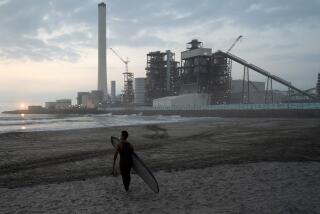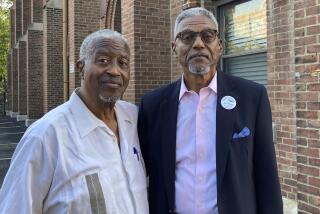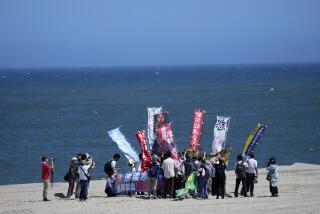France Detonates Nuclear Device at Pacific Test Site : Weapons: Controversial blast is first in a proposed series of eight. Worldwide protests condemn explosion.
- Share via
PARIS — Defying growing worldwide protests, France began a series of nuclear weapons tests Tuesday, detonating a nuclear device at remote Mururoa atoll in the South Pacific.
The underground explosion marked the first of as many as eight tests that the French government has said it will conduct in the South Pacific through May, and it is sure to add fuel to the international campaign against France that has spawned angry demonstrations from Australia to Japan to France.
“These programs are indispensable so that we can be in a position to guarantee the viability and the certainty of our nuclear arms in the long term,” said a statement issued by the French Defense Ministry. “The nuclear deterrent guarantees our independence and the ultimate protection of our vital interests.”
The bomb--the equivalent of less than 20,000 tons of TNT--was detonated at 12:30 p.m. (2:30 p.m. PDT), according to Col. Abel Moittier, a French military spokesman in Papeete, Tahiti, the capital of French Polynesia in the South Pacific.
“This is the first test, but it has to be the absolute last,” said Sebia Hawkins, a spokesman in Fiji for the environmental group Greenpeace, which has repeatedly mounted protests against France’s nuclear-testing plans. “The world has to unleash as much pressure as it possibly can at this stage to ensure this becomes a reality.”
French President Jacques Chirac had decided during the summer to begin what he described as a final round of tests at the French-owned Pacific atolls of Mururoa and Fangataufa, arguing that the explosions would give scientists important information and allow them to do future tests by computer simulation.
He also has promised that when the testing is complete, France will end its tests and sign an international nuclear test ban treaty.
In Washington on Tuesday, the White House issued a statement expressing regret at the French move.
“We continue to urge all of the nuclear powers, including France, to refrain from further nuclear tests and to join in a global moratorium as we work to complete and sign a comprehensive test ban treaty in 1996,” the statement said.
Last month, U.S. diplomats, who had earlier pressed the French not to conduct the tests at all, asked Chirac’s government to at least refrain from staging the test while President Clinton was presiding over V-J Day commemorations in Hawaii over the weekend.
Congressman Eni Faleomavaega, the non-voting delegate from American Samoa in the Pacific, denounced the tests as “a very sad commentary on French colonialism” and called for a worldwide boycott of French products.
Faleomavaega, a Democrat, had returned earlier Tuesday from French Polynesia, where French commandos had arrested and briefly detained him while he was aboard the Greenpeace ship Rainbow Warrior 2 near Mururoa over the weekend.
The Tuesday blast ended France’s 3 1/2-year-old moratorium on nuclear tests, which former President Francois Mitterrand declared without consulting his own scientists or military officials.
Between 1960 and 1992, France conducted 204 nuclear tests, 17 of them in the 1960s in the Sahara desert and the remainder in French Polynesia. Mururoa has been used for most of those. Although Australia has been one of the most vocal opponents of the resumption of French tests, the French atolls are actually closer to Los Angeles than to Sydney.
Opponents of the tests, arguing that they could damage the environment, had employed a wide variety of tactics in an effort to persuade Chirac to back away from his decision. Dozens of marches and hunger strikes have been staged in Papeete, about 600 miles northwest of the blast site, as well as in Australia, Japan and France.
Protesters in Australia have burned the French flag--one person even set fire to a French consulate--and the Australian government is engaged in a trade war with France over the issue. Police in Paris last week banned a protest march through the center of the city and then arrested 300 demonstrators trying to deliver a petition to Chirac’s office at the Elysee Palace.
In Europe, anti-nuclear activists have called on consumers to launch their own economic boycott against French products, particularly wine and other well-known symbols of the country. About 3 million people have signed petitions against the tests, including 1,200 French scientists.
Greenpeace has sailed its flagship Rainbow Warrior 2 to within a few miles of the Mururoa atoll. The ship has twice been stopped by French commandos and towed back into international waters. During the last clash with Greenpeace, on Friday, French military officers also arrested several divers who swam beneath the testing platform.
France and China are the only countries known to be conducting nuclear tests. China carried out its most recent test last month.
Seeking to counter widespread condemnation of the tests, which are opposed by 60% of the French according to recent opinion polls, the French government has released a barrage of information on its nuclear program, including details of radiation contamination. It even invited foreign reporters to Mururoa, a closed atoll, last month to answer questions about its program.
French government scientists contend that of the more than 200 tests the country has conducted in the past, only three have caused radiation contamination. Two tests in 1966 and a third in 1973 caused some contamination at Mururoa and 25 miles away at Fangataufa, which the government says was cleaned up.
Current government statistics indicate that the level of radiation in the atolls is lower than in France, where the effects of the 1986 Chernobyl nuclear plant accident in the former Soviet Union still are measurable, although not considered to be a health threat. In the lagoon waters of the atolls, radiation levels are slightly above normal but still below levels in the Baltic Sea, according to the French.
But anti-nuclear activists argue that the tests may have done damage, still undetected, to the fragile coral reef. Atolls are used in nuclear testing because they lie atop great volcanic mountains on the floor of the ocean. Coral adheres to the mountain, thickening and growing upward over millions of years, eventually creating a strip of land above water that is the atoll.
Nuclear tests are typically carried out deep inside the dead volcanic mountains. Scientists dig a well 2,000 to 3,000 feet deep, then put long cylinders into the well that contain measuring equipment and the nuclear device. When the device is detonated, sensors have one-millionth of a second to record the blast data before they are destroyed.
French scientists told reporters in Mururoa last month that the blasts create a molten lava inside the well that turns within minutes into a glass-like substance that traps the radioactivity in the mountain. About 2,000 French soldiers, sailors, scientists and technicians live on Mururoa.
Times staff writers Stanley Meisler in Washington and Doyle McManus in Selma, Calif., contributed to this report.
More to Read
Sign up for Essential California
The most important California stories and recommendations in your inbox every morning.
You may occasionally receive promotional content from the Los Angeles Times.











